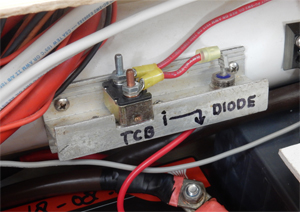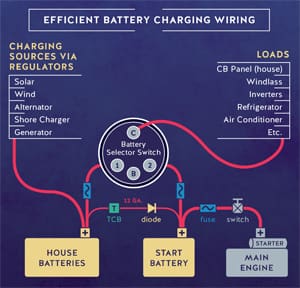If you are a cruiser who has enough to do planning social activities, ensuring you are prepared for sunset happy hour every evening, and constantly worrying about whether or not your expensive batteries are being properly charged, this idea might be for you.
It meets most of my criteria for the design of good cruising equipment: it is cheap, does its job well, is lightweight and takes little space, is simple and you can fix it yourself with onboard spares and tools.
The goal is to keep your starter battery charged without having to remember to flip your battery switch, and without worrying about your starter battery deep-cycling with your house bank.
This simple charging system worked flawlessly for me for 19 years on our CSY 44 monohull. It takes the place of purchasing expensive isolators, combiners, eliminators and relays. It is much better than the way the boat was set up when I bought it in 1996. Back then, I had to turn the battery selector switch from “Battery 1” to “Battery 2” in order to switch from house to starter battery charging; afterward, I had to remember to turn it back again. That is just too hard for an aging cruiser with so many other responsibilities to deal with!
While loaded, this system keeps the house bank and starter battery isolated from each other, using the house bank to provide for house loads and the starter battery to do engine starting. It allows for emergency starting with the house bank and keeps the starter battery always full.
It is also a better way to charge both your house bank and starting battery at the same time from charging sources with a single output. The system allows multi-step charging for the house bank and trickle charging for the start battery. It uses a simple, effective and inexpensive system originally shown to me by Bill Owra, formerly of Everfair Enterprises in Florida. I have modified his wiring somewhat to fit my needs.
Below is a description of the positive connections on a graphic layout and pictures of the two necessary electrical components.
Charging sources
First, connect all your charging sources (solar, alternator, shore charger, generator, wind, etc.) directly to the house bank via bus bars/terminal strips, their independent regulators, circuit breakers/fuses and switches. Do not use a circuit breaker or switch in the charging wire between the alternator and batteries or you run the risk of damaging diodes if the circuit opens inadvertently. Run all your charging and temperature sensor wires to the house bank.
Connect your starting battery directly to the starter via an appropriately sized large fuse and switch. Tip: If you use a switch with a removable handle, you might be able to prevent a thief from starting your engine.
Connect the house bank to terminal 1 of the battery selector switch and the start battery to terminal 2.
Connect all your loads (house circuit breakers, windlass, inverters, refrigerator, etc.) to the common terminal of your battery selector switch. This is best done using bus bars and terminal strips so that a minimum of larger wires runs to the battery selector switch. Some prefer to run bilge pumps and radios directly to the house bank; I do not. Add cutout switches and fuses as necessary in the battery cables. Large fuses should be within 18 inches of the batteries for better fire safety and compliance with ABYC specs.
 |
|
The heart of McCampbell’s charging system is a thermal circuit breaker and a Schottky diode that he has set up on an aluminum base plate in his battery compartment. |
Thermal circuit breaker is key
Finally, connect the positive post of the house bank and starting batteries together with marine 12-gauge wire, a 20-amp thermal circuit breaker (TCB) and a 60-amp diode on a small heat sink. The diode keeps current going only toward the start battery, trickle charging it when the house bank voltage gets approximately 0.5 volts above it. The TCB breaks the circuit if there is a problem with high amperage going to the start battery (high amperage in the 12-gauge wire produces heat). You will have a choice of how the TCB resets; choose what best fits your installation.
This system keeps the starter battery isolated and always fully charged with no deep-cycling. It is similar to the charging system in your car, keeping the starter battery always topped up. The house bank does the cycling, receives most of the charging current and handles all the loads, except that of the engine starter.
If you leave the battery selector switch on “Battery 1” — the normal situation — the house bank runs all the house loads, the starting battery starts the engine and the house bank trickle charges the starter battery. The two batteries/banks are isolated except for the small trickle charging circuit. If the starter battery weakens, place the switch on “Both” to combine them for starting.
If you get a shorted cell in the starter battery, the TCB will break the circuit and isolate that battery from the house bank. That is the reason for the TCB.
I have watched my system closely when starting my 60-hp Perkins engine and charging the house bank. A good starting battery (rated about 600 cold cranking amps or better) should not drop below about 10.5 volts while starting the engine. As long as your engine starts as it should, within a few seconds it will draw only a couple of amp-hours out of the starting battery. I have never seen more than two amps trickle charging back into my starter battery using this system. Normally, I see more like half an amp trickle charging into the starter battery when charging the house bank.
The charging system works well and is every bit as good and safe as commercially available devices that perform similarly. And any boat, even a catamaran, can carry a set of the inexpensive, lightweight and small spares. The TCB and diode together costs less than $30. They are available through most good online electronics stores.
It doesn’t get much better than this. Even an electronically challenged cruiser like me can wire this!
Dave McCampbell is a retired USN diving and salvage officer with almost 50 years of sailing and eight sailboats’ worth of maintenance experience. He and wife Sherry, currently in the Philippines, spent eight years crossing the Pacific. They voyage aboard a St. Francis 44 catamaran called Soggy Paws.

